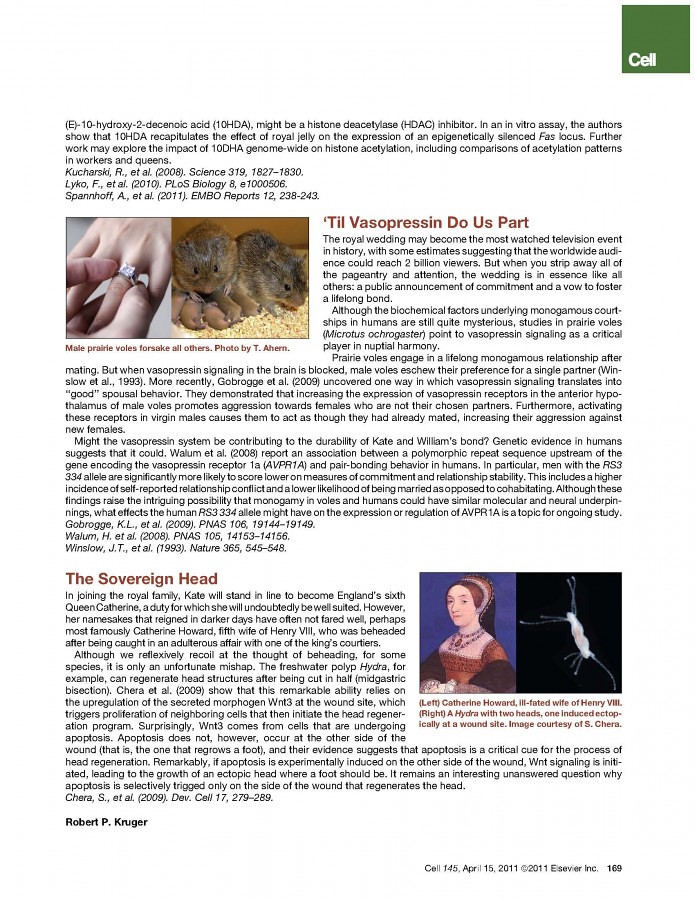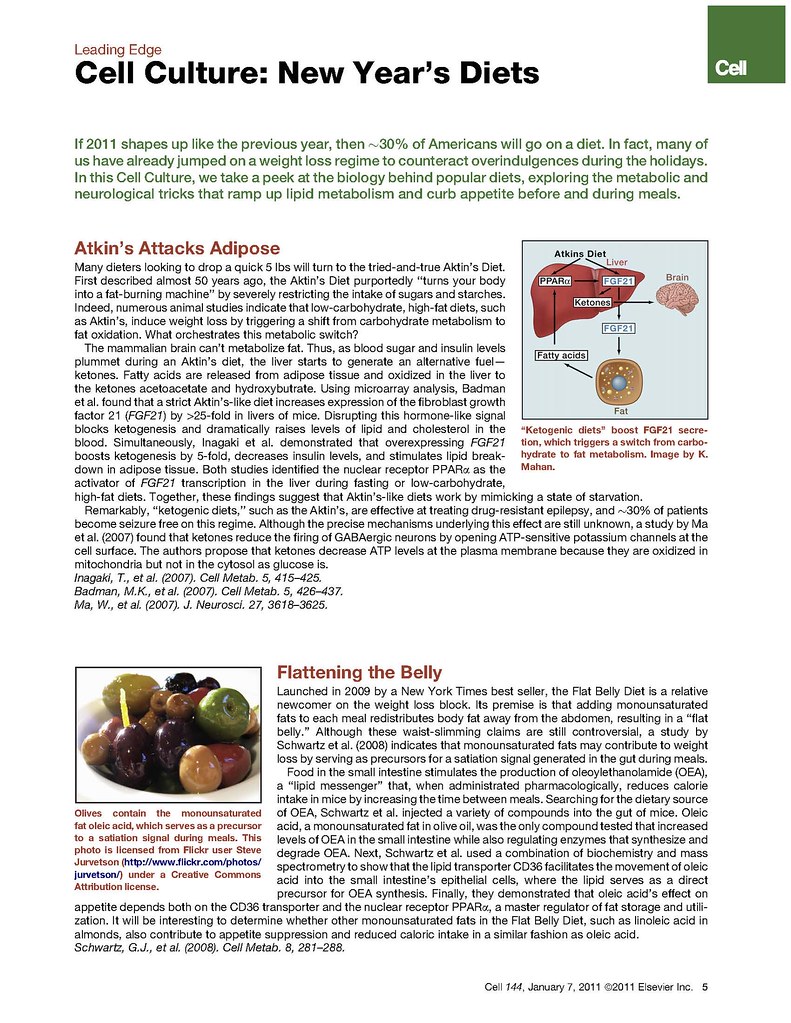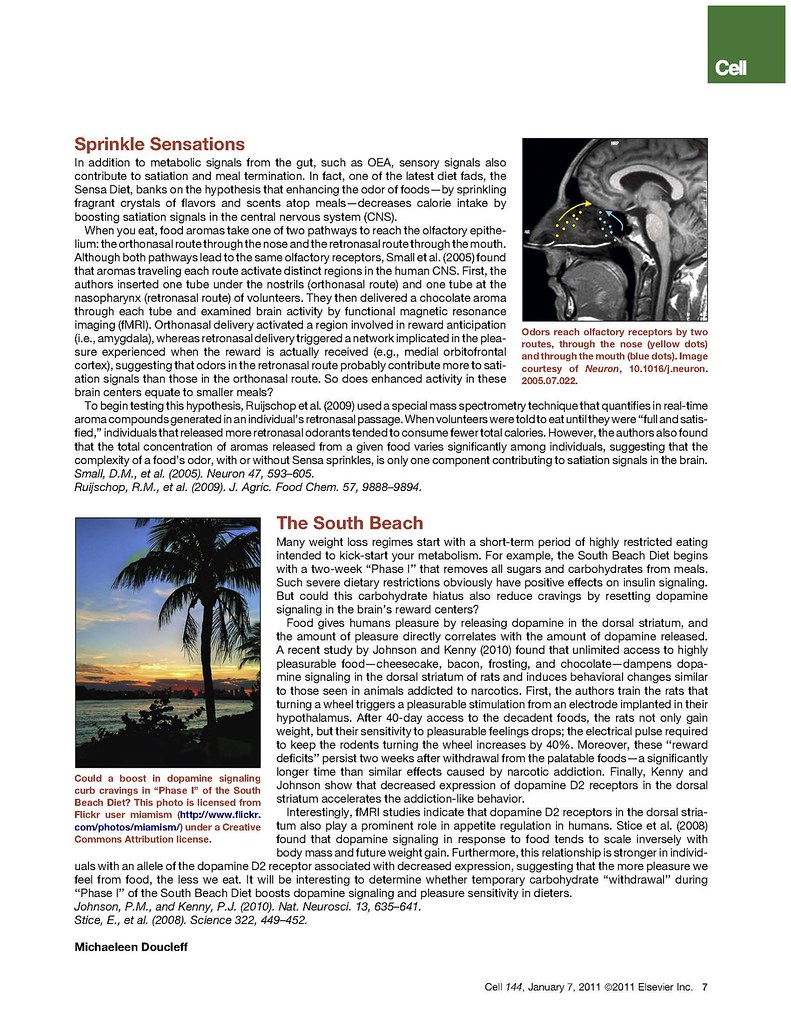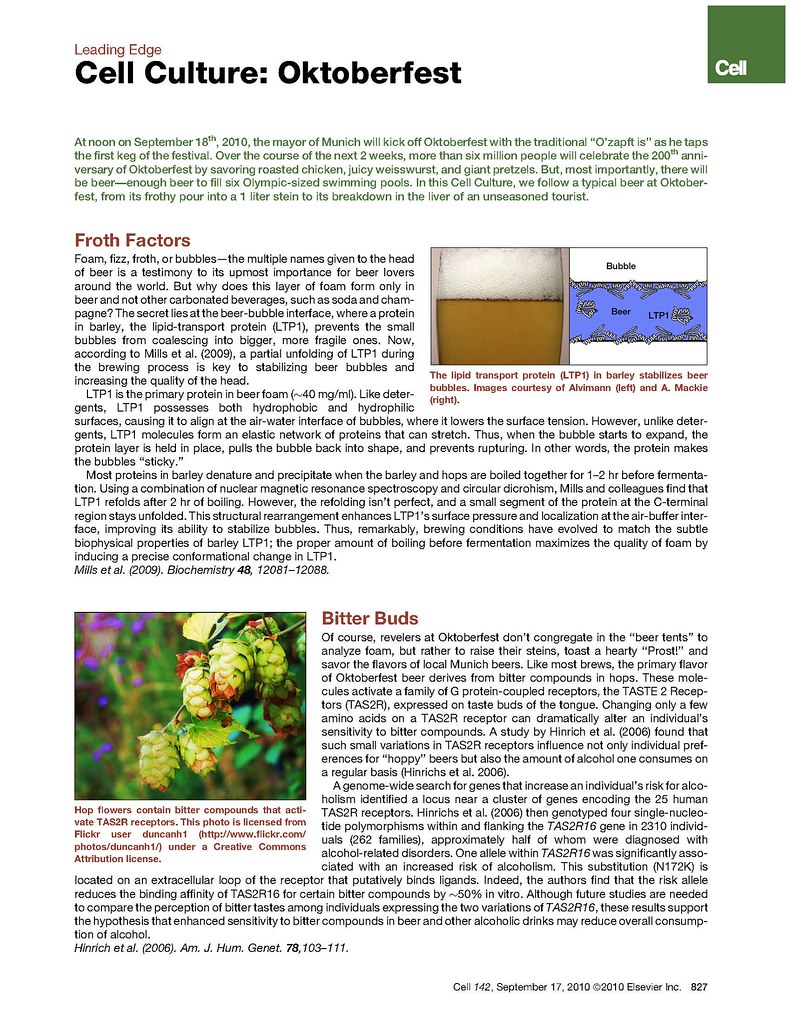Volume 145, Issue 2, 15 April 2011, Pages 167, 169
Royal Wedding
Available online 14 April 2011.
On Friday the 29th of April, 2011, England's Prince William will marry the graceful and poised Miss Catherine Middleton in London's hallowed Westminster Abbey. As the world tunes in to watch the “wedding of the century,” Cell Culture explores the more biological aspects of this historic union, including the neurocircuits that strengthen a marriage, the epigenetic changes that transform a “commoner” into a queen, and the search process for finding a high-affinity partner in a sea of weak interactions.
Finding “The One”
A decade ago, when Prince William announced that he was enrolling at the University of St. Andrews, its number of female applicants rose by 85%, reflecting his status at the time as the world's most eligible bachelor. Although few can relate to William's particular challenge of searching for a future bride amidst such an overwhelming number of would-be princesses, his problem was reminiscent of a dilemma that confronts transcription factors, which must scan extraordinarily long stretches of DNA to find appropriate targets at which to initiate gene expression.
Using-single molecule imaging, Tafvizi et al. (2011) have recently revealed the intricacies of how the tumor suppressor p53 optimizes its search for sequence-specific binding sites. They examine the movement of recombinant proteins along DNA and tease apart the distinct roles of p53's two DNA-binding regions: a core domain that mediates sequence-specific binding and a C-terminal domain that binds DNA nonspecifically. They show that a recombinant protein that consists of only the C-terminal domain slides along DNA very quickly—much faster than full-length p53—and then show that a protein consisting of just the core DNA-binding domain does not slide at all. Given these results, the authors propose that p53 might alternate between different conformational modes, a fast “search” mode (to quickly scan many candidates) and a stalled “recognition” mode (reserved for the most promising sites). They also show that, even though the core domain does not slide, it can still move between different sites via a “hopping” mechanism, meaning that it becomes fully disengaged from the DNA before finding another binding site. They propose a model, consistent with prior theoretical work, in which p53 optimizes its quest for sequence-specific binding sites by spending part of its time scanning linear DNA segments and part of its time hopping in three-dimensional space between different regions of the genome.
Tafvizi, A., et al. (2011). Proc. Natl. Acad. Sci. USA 108, 563–568.
My Fair Larvae
Kate Middleton's middle-class upbringing in Berkshire has been much talked about, and in many circles, it is celebrated as a sign of increasing harmony between the social classes. By choosing their future queen from amongst the commoners, the Britons are taking a cue from another successful eusocial group: the honeybees (Apis mellifera). When honeybees need a new queen, they select larvae, which would otherwise become ordinary worker bees, and feed them a sustained diet of “royal jelly,” which transforms the larvae into queens. Characterizing the molecular mechanisms underlying this transformation has provided surprising new insight into how dietary factors impact the epigenome.
To learn about the reprogramming magic of royal jelly, Kucharski et al. (2008) used RNA interference to reduce expression of known epigenetic regulators. Remarkably, the loss of a single factor, the DNA cytosine-5-methyltransferase 3 (Dnmt3) initiates queen development. Among the effects of Dnmt3 downregulation is a massive expansion of ovarian tissue, which allows a queen to fulfill its role as mother to the hive. In a subsequent study, Lyko et al. (2010) examined the genomic distribution of methylcytosine in brain tissue from queens and workers. They found a correlation between changes in methylcytosine near splice sites, suggesting that alternative splicing could be one consequence of altered methyltransferase activity (Lyko et al., 2010).
Although it is still unclear what compound in royal jelly might affect the activity of methyltransferases, Sphannhoff et al. (2011) recently reported that one of its major constituents, the fatty acid (E)-10-hydroxy-2-decenoic acid (10HDA), might be a histone deacetylase (HDAC) inhibitor. In an in vitro assay, the authors show that 10HDA recapitulates the effect of royal jelly on the expression of an epigenetically silenced Fas locus. Further work may explore the impact of 10DHA genome-wide on histone acetylation, including comparisons of acetylation patterns in workers and queens.
Kucharski, R., et al. (2008). Science 319, 1827–1830.
Lyko, F., et al. (2010). PLoS Biology 8, e1000506.
Spannhoff, A., et al. (2011). EMBO Reports 12, 238-243.
‘Til Vasopressin Do Us Part
The royal wedding may become the most watched television event in history, with some estimates suggesting that the worldwide audience could reach 2 billion viewers. But when you strip away all of the pageantry and attention, the wedding is in essence like all others: a public announcement of commitment and a vow to foster a lifelong bond.
Although the biochemical factors underlying monogamous courtships in humans are still quite mysterious, studies in prairie voles (Microtus ochrogaster) point to vasopressin signaling as a critical player in nuptial harmony.
Prairie voles engage in a lifelong monogamous relationship after mating. But when vasopressin signaling in the brain is blocked, male voles eschew their preference for a single partner (Winslow et al., 1993). More recently, Gobrogge et al. (2009) uncovered one way in which vasopressin signaling translates into “good” spousal behavior. They demonstrated that increasing the expression of vasopressin receptors in the anterior hypothalamus of male voles promotes aggression towards females who are not their chosen partners. Furthermore, activating these receptors in virgin males causes them to act as though they had already mated, increasing their aggression against new females.
Might the vasopressin system be contributing to the durability of Kate and William's bond? Genetic evidence in humans suggests that it could. Walum et al. (2008) report an association between a polymorphic repeat sequence upstream of the gene encoding the vasopressin receptor 1a (AVPR1A) and pair-bonding behavior in humans. In particular, men with the RS3 334 allele are significantly more likely to score lower on measures of commitment and relationship stability. This includes a higher incidence of self-reported relationship conflict and a lower likelihood of being married as opposed to cohabitating. Although these findings raise the intriguing possibility that monogamy in voles and humans could have similar molecular and neural underpinnings, what effects the human RS3 334 allele might have on the expression or regulation of AVPR1A is a topic for ongoing study.
Gobrogge, K.L., et al. (2009). PNAS 106, 19144–19149.
Walum, H. et al. (2008). PNAS 105, 14153–14156.
Winslow, J.T., et al. (1993). Nature 365, 545–548.
The Sovereign Head
In joining the royal family, Kate will stand in line to become England's sixth Queen Catherine, a duty for which she will undoubtedly be well suited. However, her namesakes that reigned in darker days have often not fared well, perhaps most famously Catherine Howard, fifth wife of Henry VIII, who was beheaded after being caught in an adulterous affair with one of the king's courtiers.
Although we reflexively recoil at the thought of beheading, for some species, it is only an unfortunate mishap. The freshwater polyp Hydra, for example, can regenerate head structures after being cut in half (midgastric bisection). Chera et al. (2009) show that this remarkable ability relies on the upregulation of the secreted morphogen Wnt3 at the wound site, which triggers proliferation of neighboring cells that then initiate the head regeneration program. Surprisingly, Wnt3 comes from cells that are undergoing apoptosis. Apoptosis does not, however, occur at the other side of the wound (that is, the one that regrows a foot), and their evidence suggests that apoptosis is a critical cue for the process of head regeneration. Remarkably, if apoptosis is experimentally induced on the other side of the wound, Wnt signaling is initiated, leading to the growth of an ectopic head where a foot should be. It remains an interesting unanswered question why apoptosis is selectively trigged only on the side of the wound that regenerates the head.
Chera, S., et al. (2009). Dev. Cell 17, 279–289.







